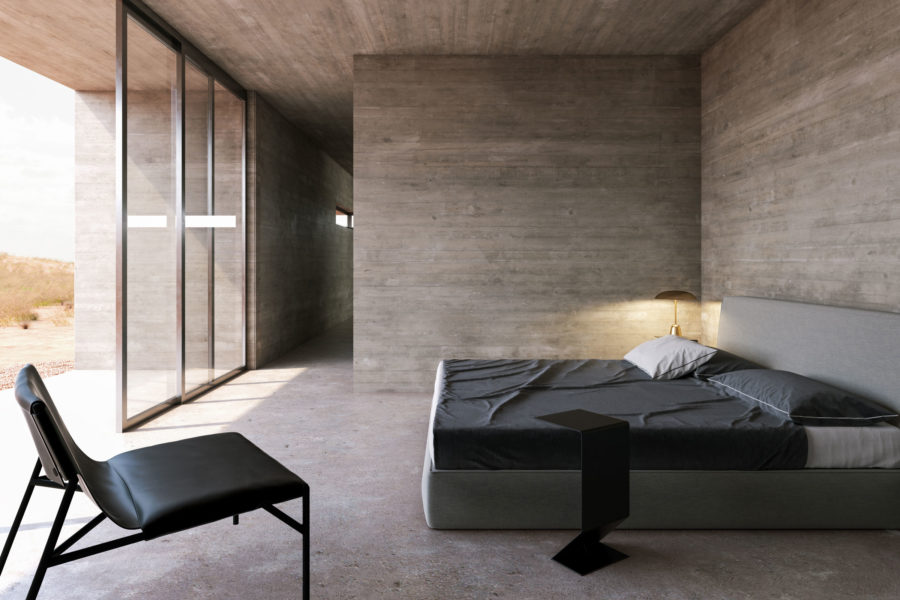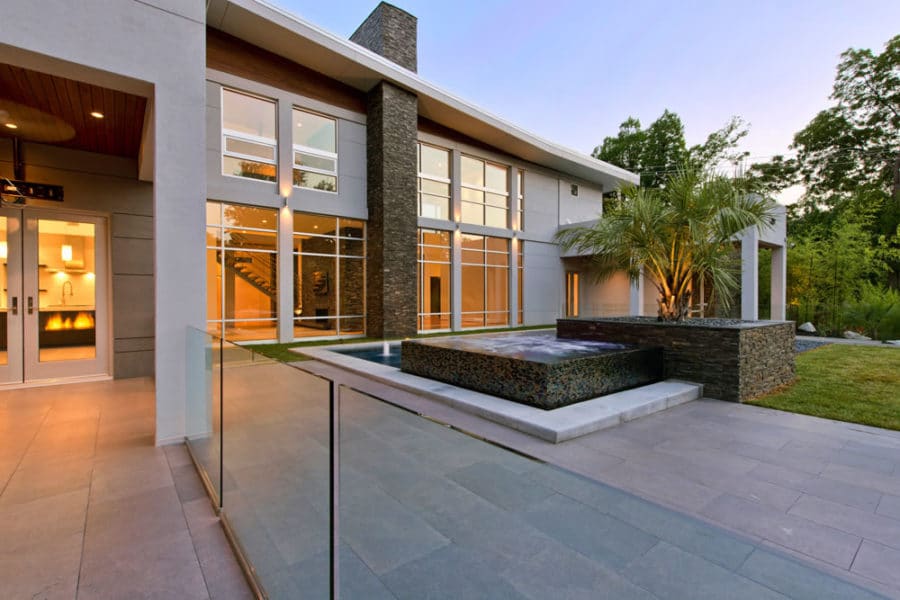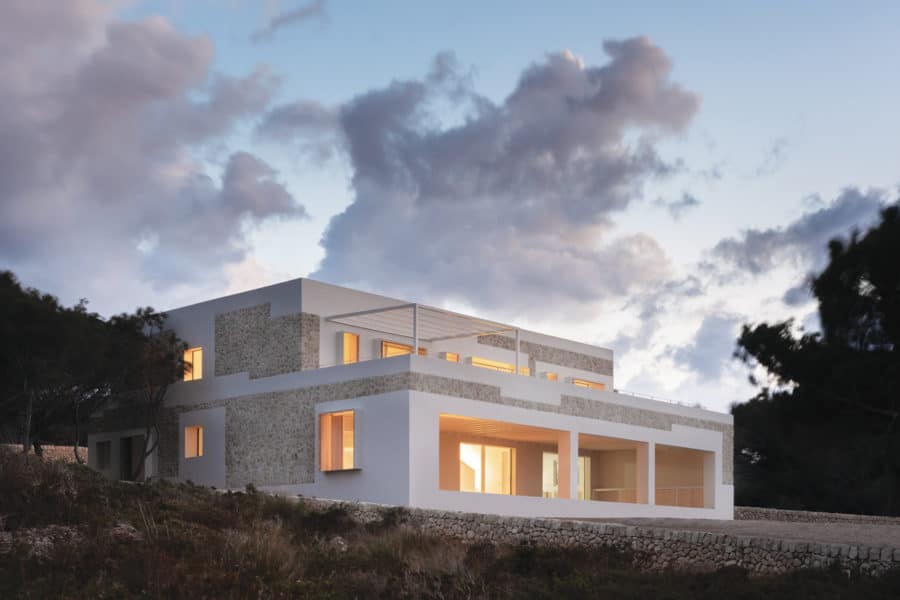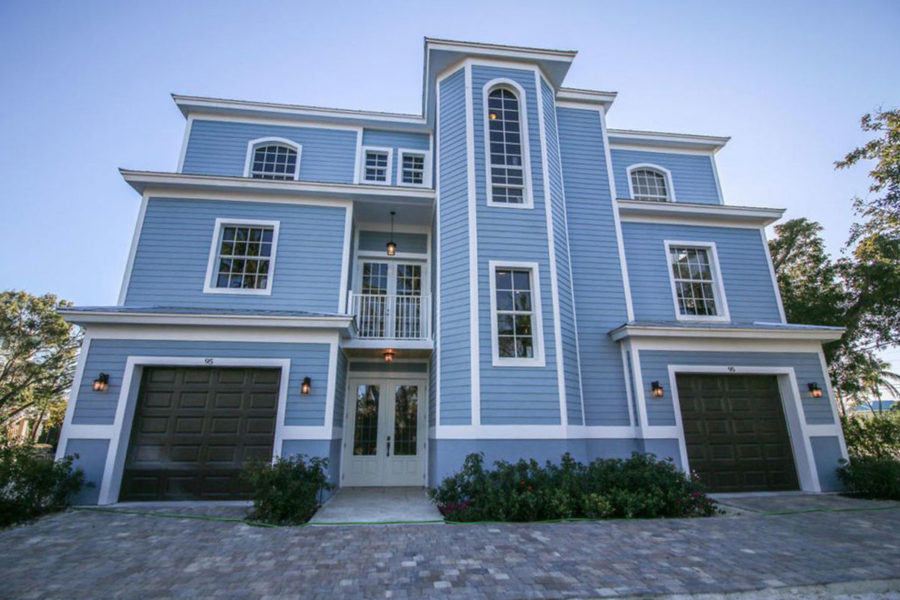Story at a glance:
- Using concrete for your home design can reduce heating and cooling costs.
- One architect turns to exposed concrete for its integrity as an “honest” material.
- Building with insulated concrete forms can improve occupant comfort and safety.
Concrete homes are nothing new; they’re loved for their durability and longevity as well as cost-effectiveness in design. But while concrete has long had a place in residential construction, some architects are using concrete in surprising ways—playing with color and adding texture, for example.
We’ve detailed some of our favorite ways concrete is being used in design, from unexpected concrete homes to incredibly energy-efficient homes.
What is a Concrete Home?
Concrete homes often look just like stick-built homes—or those houses built with a wood frame that supports plywood and other building materials. But then they also incorporate insulated concrete forms (ICFs)—stacked and braced before concrete is poured inside the forms, according to the Concrete Network.
Concrete homes can help to reduce heating and cooling costs and also stand up to strong storms or even hurricanes and tornadoes.
Adequate housing is in dire need, too, according to Thomas Guillott, chief executive at the Global Cement and Concrete Association (GCCA).
“Three-quarters of the infrastructure that the world needs by 2050 has yet to be built. And concrete will play an essential role in creating the homes and infrastructure of the future,” he said in a previous gb&d article.
The Advantages and Disadvantages of Concrete Homes
Designing and building a concrete home comes with its own advantages and disadvantages, of course, and can vary widely depending on the look architects are after and the materials they have available.
Advantages
The advantages of concrete homes are many—from saving dollars to having better control of sound. These are some of the top advantages of concrete homes.
Lower Energy Bills
Thanks in large part to the insulating power of ICFs, homeowners can expect to save 20 to 25% in annual heating and cooling costs versus standard stick-built homes, according to the US Department of Housing and Urban Development. The Concrete Network reports that those savings depend in part on the energy efficiency of a project’s windows and doors as well as the area’s climate.
Acoustic Benefits
Living in a concrete home typically means living with less noise seeping in from outside.
Concrete masonry is an ideal noise control material, according to the National Concrete Masonry Association (NCMA). The NCMA points to how concrete acts as a barrier by diffusing incident noise over a wide range of frequencies. It can also be an effective sound absorption material for absorbing noise generated within a room.
Occupant Comfort
Concrete homes are also typically less drafty than other types of construction, as they block out the wind. The foam-and-concrete barrier cuts air infiltration by as much as 75% when compared with a typical frame house. The high thermal mass of the concrete also buffers the home’s interior from extreme outdoor temperatures, while the continuous layer of foam insulation minimizes temperature fluctuations inside the home by eliminating the cold spots that can occur in frame walls along the studs or at gaps in the insulation, according to the Concrete Network.
Resiliency
Houses built using concrete masonry can withstand extreme events, whether that’s an earthquake, hurricane, tornado, fire, or other extreme event, the NCMA says.
Concrete homes keep occupants safe from high winds, as an ICF wall at a minimum can withstand 150 mile per hour winds. The steel reinforced concrete inside that wall provides structural stability, even from large debris. The foam on the outside delivers a large cushioning effect, too.
Disadvantages
Of course designing and building a concrete home has its cons, too, from extra dollars upfront to finding the right team to build the house. These are some of the disadvantages of concrete homes.
Initial Cost
The price of concrete fluctuates, but often architects and builders will have to deal with a higher initial cost when choosing concrete over some other building materials. The cost of using concrete blocks instead of wood framing and drywall can be up to three times higher in some regions, according to Green Garage Blog. That said, you typically make up for those costs with energy savings.
Aesthetics
Let’s face it. Not everyone loves the look of concrete. Some may consider it a bit too cold or a bit too Brutalist. Though there are many options for dressing up concrete these days with innovative facades or mixing and matching materials like warm woods.
Skill
Concrete homes can take more time and skill to build than perhaps some other alternatives. For concrete houses, builders need to be familiar with working with ICFs, for example.
The Average Costs of Concrete Homes
Your average 2,200-square-foot concrete houses is between $240,000 and $445,000, according to Home Advisor. Currently, due to rising lumber prices, that’s about 5 to 10% more to build an ICF home over a stick-built house. Still, you can expect to recover those costs in energy savings.
According to a study by the National Association of Home Builders the average new home in 2019 was around 2,600 square feet and cost about $300,000 to build. At that time building a concrete home with ICFs would add 3 to 5% to the price.
Concrete Block vs. Insulated Concrete Forms
What exactly is the different between concrete block and ICFs? A concrete block is quite literally a building block made entirely of concrete that is then mortared together for long-lasting construction.
Concrete blocks can be hollow or solid and formed using ordinary or lightweight concrete in various specified sizes, depending on the requirements. They are made from cement, aggregate, and water. The cement-aggregate ratio is 1 to 6.
Pros of Concrete Block
- Cost
- Access to Labor
Cons of Concrete Block
- Aesthetics
- May be subject to water seepage over time
ICF walls are large concrete walls without joints. They’re said to be much stronger than those built with concrete blocks. BuildBlock ICF technology combines strong and long-lasting concrete and steel reinforcement with the superior insulation of expanded polystyrene (EPS) foam.
Pros of ICFs
- Energy-efficient
- Allow for more occupant comfort
- Resilient
Cons of ICFs
- Cost
- Energy to produce
- Skilled labor
Concrete Home Designs & Inspiration
Today’s concrete home designs run the gamut from exposed concrete and Neo-Brutalist to concrete houses that incorporate other materials like brick, stone, or even wood. Architects and designers continue to turn to concrete for its incredible strength. Here are just some examples of inspiring concrete home design.
Exposed Cast-in-Place Concrete

According to the architect, the house is designed as a declaration against the gloss of mainstream architectural practice, which he says tends to focus on exterior “decorative” facades and arbitrary forms. Photo courtesy of Marc Thorpe Design
Marc Thorpe designed The Sharp House to be as economical as possible in construction. Concrete is the star of this design, but it also provides natural insulation to keep the house warm at night and cool during the day.
The minimalist house just north of Santa Fe is a study of space, light, and shadow, and the design takes into serious consideration its ecological impact.
Thorpe says the design could have easily been wood or another material, but the homeowners insisted on concrete. “They wanted concrete,” he says. “I personally thought concrete would be a nice material because of its tactility. And it’s an honest material, to communicate exactly what the building is.”
I personally thought concrete would be a nice material because of its tactility.
The design is reminiscent of tropical building tradition, with sweeping overhangs covering entryways and recessed ribbon windows cutting into the building’s monolithic concrete facade.
The use of every surface of the house is an intentional move on Thorpe’s part.
“There isn’t really a front or a back,” he says. “In the tradition of Frank Lloyd Wright, he designed his houses with no real entry. It was more a work of art where you’re forced to engage with the house on all sides and explore it like you would explore a piece of sculpture.
Concrete, Stone, and Corten Steel

The courtyard pool and integrated spa create a focal point for the house. Berms, low-maintenance bamboo plantings, and a 48-inch wall screen the pool area from neighbors and help fulfill a request for hassle-free landscaping.
Designed by Lake|Flato, the Courtyard House in El Paso juxtaposes concrete, stone, and Corten steel with interior walls of quarter-sawn walnut and slatted wood ceilings.
The home’s materiality connects the project to the existing home through a large courtyard. The courtyard acts as storm water retention and is defined by gabion walls, which are seen throughout the project to define indoor/outdoor courtyard spaces.
This updated design is the result of an add-on to the family’s original cast-in-place concrete house. The sleek concrete building, adorned with Corten overhangs and punctuated by gabion walls, hides an expansive courtyard that both offers refuge from and a celebration of the elements.
Exposed Concrete

Photo by Joan Guillamat
A mix of materials works together to balance the minimalist aesthetic in this Mexico City house.
Exterior walls are primarily white, and exposed concrete elements create a neutral palette. Textured tiles embellish the rooftop terrace, and a black steel staircase runs through the center of the house. Accent walls, skylights, and wooden louvers bring warmth.
Cachai House was originally built in the 1960s before being reimagined by architects Taller Paralelo in 2018. “Taking advantage of an existing structure makes it a little more interesting,” Mikel Merodio, founding partner and director of architecture firm Taller Paralelo, previously told gb&d. Using what they already had also meant producing a lot less waste.
What are Insulated Concrete Forms?

Photo courtesy of ICFMA
Many architects and builders are turning to concrete in another way for their projects.
Insulated concrete forms, or ICFs, have many benefits that lead to improved building performance, from resiliency to improved air quality. They’re incredibly strong, proven to stand up to extreme weather conditions and the test of time.
Brian Corder, marketing chair of the ICFMA (Insulating Concrete Forms Manufacturers Association) and president of BuildBlock, says ICFs deliver five core benefits—energy efficiency, comfort, quietness, improved air quality, and disaster resiliency.
An ICF is literally what it stands for—an insulated concrete form, or EPS foam insulation filled with reinforced concrete. ICFs are suited for many built environments, whether in cold weather or warm. And because the EPS insulation in ICFs is protected and stable, it won’t fail when needed most. The EPS insulation lasts for centuries, and the concrete stands up to tornadoes and hurricanes.
At a minimum, an ICF wall can withstand 150 mile per hour winds. The steel reinforced concrete inside that wall provides structural stability, even from large debris. The foam on the outside delivers a large cushioning effect, too.
Concrete House Lifespan
Structural engineers say the lifespan of any concrete structure ranges from 75 to 100 years, according to housing.com. This all depends, of course, on the type of building and its design. Elements like extreme weather can also deteriorate concrete over time. The concrete may develop cracks, and water seepage may damage the internal walls.
Stand-alone concrete houses have a higher lifespan than, say, an apartment. That said, houses that are maintained properly can increase their lifespan even more.
Some maintenance tips for a concrete home include:
- Seal your concrete to minimize water intrusion.
- Clean concrete to remove normal dirt and grime at least once a year.
- Avoid the wrong chemicals when cleaning.




